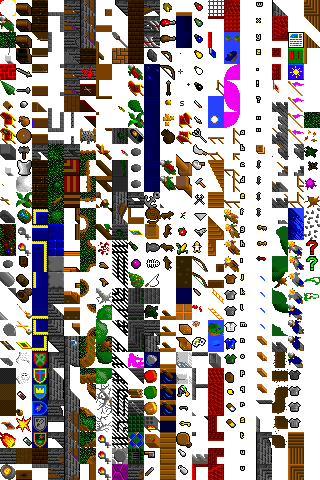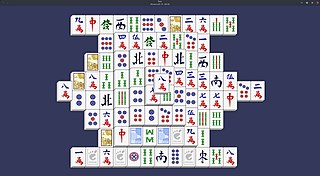
Mahjong or mah-jongg is a tile-based game that was developed in the 19th century in China and has spread throughout the world since the early 20th century. It is played by four players. The game and its regional variants are widely played throughout East and Southeast Asia and have also become popular in Western countries. The game has also been adapted into a widespread online entertainment. Similar to the Western card game rummy, mahjong is a game of skill, strategy, and luck. To distinguish it from mahjong solitaire, it is sometimes referred to as mahjong rummy.

Solitaire is any tabletop game which one can play by oneself, usually with cards, but also with dominoes. The term "solitaire" is also used for single-player games of concentration and skill using a set layout tiles, pegs or stones. These games include peg solitaire and mahjong solitaire. The game is most often played by one person, but can incorporate others.

SameGame (さめがめ) is a tile-matching puzzle video game originally released under the name CHAIN SHOT in 1985 by Kuniaki "Morisuke" Moribe. It has since been ported to numerous computer platforms, handheld devices, and even TiVo, with new versions as of 2016.

Puzzle video games make up a broad genre of video games that emphasize puzzle solving. The types of puzzles can test problem-solving skills, including logic, pattern recognition, sequence solving, spatial recognition, and word completion. Many puzzle games involve a real-time element and require quick thinking, such as Tetris (1985) and Lemmings (1991).

Rampart is a 1990 video game released by Atari Games and Midway Games that combines the shoot 'em up, strategy, and puzzle genres. It debuted as an arcade game with trackball controls, and was ported to home systems. It had a limited US release in October 1990, and a wide release in early 1991. It was distributed in Japan by Namco.
Scoring in Mahjong, a game for four players that originated in China, involves the players obtaining points for their hand of tiles, then paying each other based on the differences in their score and who obtained mahjong. The points are given a monetary value agreed by the players. Although in many variations scoreless hands are possible, many require that hands be of some point value in order to win the round.

Shisen-Sho, sometimes referred to as 'Shisen', 'Four Rivers' or simply 'Rivers,' is a Japanese tile-based game which uses Mahjong tiles, and is similar to Mahjong solitaire. The objective of the game is to match similar tiles in pairs until every tile has been removed from the playing field. Numerous computer based versions of the game have been developed.
Hoyle's Official Book of Games is a series of games developed and published by Sierra On-Line. Volume 1, released in 1989, featured multi-player card games. Volume 2, released in 1990, featured 28 varieties of Solitaire. Volume 3, released in 1991, featured board games. Volume 4, was a remake of Volume 1, with two additional games. Sierra continued to publish more games to the series up to its demise. Encore Software has continued publishing entries to the series since then. According to Hoyle 1, it was essentially a spiritual sequel to Sierra's Hi-Res Cribbage (1981).

Microsoft Mahjong is a computer game version of mahjong solitaire published by Microsoft. The version titled Mahjong Titans was developed by Oberon Games and included in Windows Vista and Windows 7. It takes advantage of the new graphical user interface (GUI) of Windows Vista, and includes features such as tile set and background choices. The game did not make it to Windows 8; however, a standalone version, developed by Arkadium and published by Microsoft Studios, can be downloaded from the Windows Store free of charge and played without download on the web.

Puzzle Quest: Challenge of the Warlords is a puzzle video game designed by Steve Fawkner for Australian game developer Infinite Interactive and published by D3 Publisher in 2007. The game combines role-playing with tile-matching elements. Taking place in a high fantasy setting, the player moves his or her character around the game's world and encounters monsters and other enemies to fight so as to gain experience and acquire treasure as in a typical role-playing game. Combat takes place on a board similar to Bejeweled, and by making matches of colored gems, the combatants can cause damage to their opponents, cast spells, or perform other abilities that affect the flow of the game.

A tile-based video game is a type of video or video game where the playing area consists of small square graphic images referred to as tiles laid out in a grid. That the screen is made of such tiles is a technical distinction, and may not be obvious to people playing the game. The complete set of tiles available for use in a playing area is called a tileset. Tile-based games usually simulate a top-down, side view, or 2.5D view of the playing area, and are almost always two-dimensional.

Shanghai is a computerized version of mahjong solitaire published by Activision in 1986 for the Amiga, Atari ST, Atari 8-bit family, Commodore 64, DOS, Macintosh, Apple IIGS and Master System. Shanghai was originally programmed by Brodie Lockard. It was released as an arcade game by Sunsoft in 1988.

A game is a structured form of play, usually undertaken for entertainment or fun, and sometimes used as an educational tool. Many games are also considered to be work or art.

Mahjong solitaire is a single-player matching game that uses a set of mahjong tiles rather than cards. It is more commonly played on a computer than as a physical tabletop game.
Japanese mahjong, also known as riichi mahjong, is a variation of mahjong. While the basic rules to the game are retained, the variation features a unique set of rules such as riichi and the use of dora. The variant is one of a few styles where discarded tiles are ordered rather than placed in a disorganized pile. This is primarily due to the furiten rule, which takes player discards into account. The variant has grown popularity due to anime, manga, and online platforms.

Three-player mahjong is a variation of mahjong for three players rather than the more common four-player variations. It is not a mere adaption of four-player mahjong to suit only three players but has its own rules and idiosyncrasies that place it apart from the more standard variations. The equipment used and the basic mechanisms are much like four-player variations though some tiles are removed, certain plays are prohibited and the scoring system is simplified. The game is embraced in some Asian countries while ignored or snubbed in others.

A tile-matching video game is a type of puzzle video game where the player manipulates tiles in order to make them disappear according to a matching criterion. In many tile-matching games, that criterion is to place a given number of tiles of the same type so that they adjoin each other. That number is often three, and these games are called match-three games.

Threes is a puzzle video game by Sirvo, an independent development team consisting of game designer Asher Vollmer, illustrator Greg Wohlwend, and composer Jimmy Hinson. The game was released on February 6, 2014, for iOS devices and later ported to Android, Xbox One, and Windows Phone. In Threes, the player slides numbered tiles on a grid to combine addends and multiples of three. The game ends when there are no moves left on the grid and the tiles are counted for a final score.

SpellTower is a puzzle video game by Zach Gage in which the player creates words from a jumble of letter tiles to clear the screen before it refills. The game has several game modes and a multiplayer battle mode. The impetus for the game—the concept of combining elements from Tetris and Boggle in what was a prototype of the puzzle video game Puzzlejuice—inspired Gage to create SpellTower. The game released for iOS in November 2011 to generally favorable reviews. Versions for OS X and Android followed over the next two years. In 2017 SpellTower Minutes was released. This browser-based Flash game created special "blitz" like modes not found in the mobile releases. A new iOS version released in 2017 swapped out the unnamed dictionary and began using Merriam-Webster's Third New International Dictionary, Unabridged. French and Dutch language specific versions were also released. A 2020 release, SpellTower+, added new game modes, cleaner visuals, and a jazz soundtrack.










